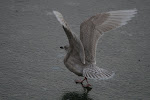It therefore came as some surprise when an inland Hume's Leaf-warbler turned up on Saturday. I decided to go for it and Alex Jones and Steff Leese picked me up from Crewe station and we were onsite within an hour.
A decent turnout for this bird, and to be honest, more than I was expecting. It hadn't been seen for 20 minutes by the time we arrived, but the sun was just about to come out, so we were hopeful. After 15 minutes or so, after meeting fellow NGBirder Craig Reed, the bird started calling and then flew across the open into vegetation. The call very educational indeed. It sounded very similar to Yellow-browed Warbler, however where YBW rises more on the second note, this bird seemed to finish the same pitch as the first one started, so sounded very similar to the 'chissik' call of Pied Wagtail.Before too long, the bird came out into the open and upon first views, I really wasn't blown away. Now before I say this is because it was a rubbish bird, it was only because it came across as really bright, with the paler parts seeming really yellow and therefore not really all that distinctive from Yellow-browed. I was a touch worried about it.
It then flew across and landed in a small hawthorn at 50ft range, and then fed actively, including flycatching and hovering. This was much much better showing almost silvery underparts and just a much more overall cold appearence. Much more like it!
In addition, the tertials seemed like them were 'misty' as in the contrast between the dark centres and the pale fringes were a lot less contrasty and the second wingbar on the median coverts was much more less distinct the the greater coverts wing bar, unlike on Yellow-browed where they are quite similar.
A really great bird that showed on and off in the sun and remained vocal throughout and whilst being so silvery, you could pick it up at great distance with the naked eye.
Next we moved onto Chasewater as Alex and I still have never seen a Caspian Gull, so with up to 5 showing regularly in the gull roost throughout the winter, we were hopeful. We got there quite early and there was only a small amount of gulls present on arrival, but 2 Yellow-legged Gulls were picked out. As a small crowd formed, it wasn't too long before a 1st winter Glaucous Gull was picked up distantly. Even at this distance, it was an enourmous bird with really obvious two-toned bill.
Alex then picked up a clean-headed, small and beady-eyed LWHG. This looked really good. The mantle shade was slightly darker than the surrounding Herring and Black-headed Gulls. The head was perfectly clean with a sloping forehead giving it a somewhat snouty look. In addition the eye was really tiny, dark and gave the face that classic 'rat-like' appearance. In terms of the bill, this looked good too being very long, very narrow and parallel-sided with next to no gonydeal angle. It had an obvious yellow-tip with a much greyer/greeny base. The red on the gonys was restricted to the lower mandible too. It was looking superb. The tertials had a really big white 'moon' which I'm not sure is a distinctive feature, but it certainly was noted. In terms of primaries, there wasn't all that much white which didn't help the case, however the primary 10 did have a white tip. It never flapped whilst we were watching it, so the underside of the primaries were never noted to the tongue on the inner web of p10 was never clinched. Everything was looking pretty bang on, however for whatever reason, it just didn't seem 100%. I can't put my finger on it, but perhaps the slightly short primary projection made it look odd?
I am not entirely sure what this bird actually is. I think the fact that we picked this bird up separately three times within the flock is a little worrying in terms of it being something good. It could well be a Caspian, but given the photos and that we didn't clinch it at the time, I think this is probably best left alone...





No comments:
Post a Comment